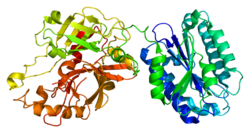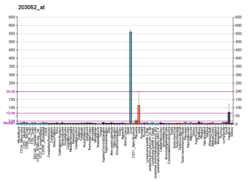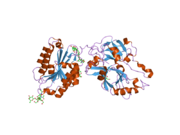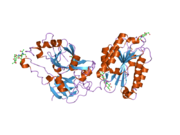| C2 | |||||||||||||||||||||||||||||||
|---|---|---|---|---|---|---|---|---|---|---|---|---|---|---|---|---|---|---|---|---|---|---|---|---|---|---|---|---|---|---|---|
 | |||||||||||||||||||||||||||||||
| |||||||||||||||||||||||||||||||
| Identifiers | |||||||||||||||||||||||||||||||
| Aliases | C2, ARMD14, CO2, complement component 2, complement C2 | ||||||||||||||||||||||||||||||
| External IDs | OMIM: 613927; MGI: 88226; HomoloGene: 45; GeneCards: C2; OMA:C2 - orthologs | ||||||||||||||||||||||||||||||
| |||||||||||||||||||||||||||||||
| |||||||||||||||||||||||||||||||
| |||||||||||||||||||||||||||||||
| |||||||||||||||||||||||||||||||
| Wikidata | |||||||||||||||||||||||||||||||
| |||||||||||||||||||||||||||||||
Complement C2 is a protein that in humans is encoded by the C2 gene.[5] The protein encoded by this gene is part of the classical pathway of the complement system, acting as a multi-domain serine protease. Deficiency of C2 has been associated with certain autoimmune diseases.[5]
The Complement system is generated to regulate self protection from infection. The overall Complement system is composed of protein groups that collaborate in destroying foreign invaders, which ultimately remove debris from cells and tissues. When the body detects a foreign invader, the body signals the Complement system and the Complement component 2 protein attaches to Complement system 4 resulting in an immune response. Complement component 2 protein is critical for regulating the body's immune response.
YouTube Encyclopedic
-
1/5Views:65 538157 535344 960958 01112 880
-
The Complement System | The most COMPREHENSIVE Explanation
-
The Complement System: Classical, Lectin, and Alternative Pathways
-
Immunology | Inflammation: Complement Proteins: Part 3
-
Complement System Made Easy- Immunology- Classical Alternate & Lectin pathway
-
Measuring complement proteins 2: C3/C4, Architect – Dipti Patel
Transcription
Function
In the classical and lectin pathways of complement activation, formation of the C3-convertase and C5-convertases requires binding of C2 to an activated surface-bound C4b in the presence of Mg2+; the resultant C4bC2 complex is cleaved by C1s or MASP2 into C2a and C2b. It is thought that cleavage of C2 by C1s, while bound to C4b, results in a conformational rotation of C2b whereas the released C2a fragment may retain most of its original structure.
C2b is the smallest, enzymatically active, fragment of C3 convertase in this pathway, C4b2b (NB: some sources now refer to the larger fragment of C2 as C2b, making the C3 convertase C4b2b, whereas older sources refer to the larger fragment of C2 as C2a, making the C3 convertase C4b2a). The smaller fragment, C2a (or C2b, depending on the source) is released into the fluid phase.[6]
Complement Component 2 Deficiency

In the Molecular Biology, the deficiency of Complement Component 2 i s a disorder that causes a major effect in the immune system, resulting in a form of immunodeficiency. This effect results in an inability to protect the body against any foreign invader. Complement component 2 deficiency is also connected with an increased risk of developing autoimmune disorders, such as systemic vasculitis. Complement deficiencies is a challenge to understand due to insufficient clinical trails. Using a hemolytic-plaque assay, RNA extraction, and blot analysis, it is fair to note that complement component 2 deficiency is a result of pre-translational regulatory detect in C2 gene expression.[7] This detects a lack of synthesis within the C2 protein. This deficiency can be further understood by incorporating plasma protein deficiencies, especially those in tissue macrophages. It is also important to note that Complement component 2 deficiency can be caused by genetic and environmental factors. In genetic inheritance, Autosomal recessive conditions are inherited with mutations in both copies of the gene where parents of autosomal recessive condition typically do not show symptoms.
Development of SLE
Complement component 2 deficiency is associated with an increased risk of developing autoimmune disorders, with females more likely to have SLE. Systemic lupus erythematosus (lupus) is a chronic autoimmune disease that causes inflammation and tissue damage, affecting many parts of the body. Lupus can range from mild to severe and can cause inflammation in organs, such as joints, skin, kidneys, and brain. The severity of the disorder varies. C2 is an important component of both the classical and lectin pathways of complement activation, and is essential for first line defense against microbial infection. It binds to MBL or ficolins to form the C3 convertase C4b2a. In C2 deficiency, C3 is not efficiently cleaved, leading to limited deposition of C3 fragments on immune complexes and apoptotic cells, leading to chronic activation of the complement system.
Treatment and Management
Complement deficiency is managed on a case-by-case basis with antibiotics and regular visits with an immunologist. A form to treat complement component 2 deficiency includes replacing the missing component of the cascade, either through direct infusion of the protein or through gene therapy. Patients should be aware of symptoms of meningococcal infection and receive routine vaccinations. Patients should seek for accessible resources offered by the medical provider and take the necessary actions needed to treat for complement deficiency.
Patient Education
Patients and parents should be educated on the symptoms of serious illness and seek care immediately. Vaccination is an important preventive measure for the deficiency of complement component 2. Early diagnosis, antibiotic prophylaxis, and vaccinations can help prevent life-threatening infections in hereditary C2 deficiency.
Promoting Health Care Outcomes
The interprofessional team must be aware of the clinical features of patients with complement deficiency or immunodeficiency, and refer them to allergist/immunologists when necessary. Infection prevention and treatment of infections are key for complement deficiencies.[8] Patient organizations build public awareness and support research to improve patients' lives. Patient organizations provide access to information, resources, and support.
Clinical Significance
Photosensitive patients with C2 type I deficiency have poor prognosis. C2 type I deficiency is caused by a 28-base pair gene deletion, resulting in premature termination codon and lack of C2 protein. Patients with LE associated with complement C4 or C2 deficiencies have a better prognosis than those without inherited deficiencies. Complement component 2 deficiency increases risk of autoimmune disorders which may be managed by receiving the adequate care. Clinically, this is significant since Complement component 2 deficiency increases the risk of recurrent bacterial infections, which may be life-threatening.
Other Names
There are numerous forms of naming this gene. For example:
- ARMD14
- C3/C5 convertase
- CO2
- complement component 2
- complement component C2
References
Citations
- ^ a b c ENSG00000235017, ENSG00000235696, ENSG00000226560, ENSG00000204364, ENSG00000166278, ENSG00000231543 GRCh38: Ensembl release 89: ENSG00000206372, ENSG00000235017, ENSG00000235696, ENSG00000226560, ENSG00000204364, ENSG00000166278, ENSG00000231543 – Ensembl, May 2017
- ^ a b c GRCm38: Ensembl release 89: ENSMUSG00000024371 – Ensembl, May 2017
- ^ "Human PubMed Reference:". National Center for Biotechnology Information, U.S. National Library of Medicine.
- ^ "Mouse PubMed Reference:". National Center for Biotechnology Information, U.S. National Library of Medicine.
- ^ a b "Entrez Gene: C2 complement component 2".
- ^ Krishnan V, Xu Y, Macon K, Volanakis JE, Narayana SV (2009). "The structure of C2b, a fragment of complement component C2 produced during C3 convertase formation". Acta Crystallographica D. 65 (Pt 3): 266–274. doi:10.1107/S0907444909000389. PMC 2651757. PMID 19237749.
- ^ Ippolito A, Wallace DJ, Gladman D, Fortin PR, Urowitz M, Werth V, et al. Auto-antibodies in systemic lupus erythematosus: comparison of historical and current assessment of seropositivity. Lupus (2011) 20:250–5. doi:10.1177/0961203310385738
- ^ "Complement Deficiencies | Immune Deficiency Foundation".
Bibliography
- Jonsson G, Truedsson L, Sturfelt G, Oxelius VA, Braconier JH, Sjoholm AG. Hereditary C2 deficiency in Sweden: frequent occurrence of invasive infection, atherosclerosis, and rheumatic disease. Medicine (Baltimore). 2005Jan;84(1):23-34. doi: 10.1097/01.md.0000152371.22747.1e. Citation on PubMed (https://pubmed.ncb[permanent dead link] i.nlm.nih.gov/15643297)
- Complement+2 at the U.S. National Library of Medicine Medical Subject Headings (MeSH) Sjöholm AG, Jönsson G, Braconier JH, Sturfelt G, Truedsson L. Complement deficiency and disease: an update. Mol Immunol. 2006 Jan;43(1-2):78-85. doi: 10.1016/j.molimm.2005.06.025. PMID 16026838.
- Wen L, Atkinson JP, Giclas PC. Clinical and laboratory evaluation of complement deficiency. J Allergy Clin Immunol. 2004 Apr;113(4):585-93; quiz 594. doi: 10.1016/j.jaci.2004.02.003. PMID 15100659.
- Chen HH, Tsai LJ, Lee KR, Chen YM, Hung WT, Chen DY. Genetic association of complement component 2 polymorphism with systemic lupus erythematosus. Tissue Antigens. 2015 Aug;86(2):122-33. doi: 10.1111/tan.12602. Epub 2015 Jul 14. PMID 26176736.
Further reading
- Bartholomew WR, Shanahan TC (1991). "Complement components and receptors: deficiencies and disease associations". Immunology Series. 52: 33–51. PMID 2091785.
- Campbell RD (Jan 1987). "The molecular genetics and polymorphism of C2 and factor B". British Medical Bulletin. 43 (1): 37–49. doi:10.1093/oxfordjournals.bmb.a072175. PMID 3315100.
- Yu CY (1999). "Molecular genetics of the human MHC complement gene cluster". Experimental and Clinical Immunogenetics. 15 (4): 213–230. doi:10.1159/000019075. PMID 10072631. S2CID 25061446.
- Lutsenko SM, Kharchenko VG, Bachurin VI, Lomakin MM (Feb 1976). "[Circulating blood volume and regional hemodynamics in acute gastrointestinal hemorrhage]". Sovetskaia Meditsina (2): 38–41. PMID 1084023.
- Zhu ZB, Hsieh SL, Bentley DR, Campbell RD, Volanakis JE (Jun 1992). "A variable number of tandem repeats locus within the human complement C2 gene is associated with a retroposon derived from a human endogenous retrovirus". The Journal of Experimental Medicine. 175 (6): 1783–1787. doi:10.1084/jem.175.6.1783. PMC 2119228. PMID 1350302.
- Lappin DF, Guc D, Hill A, McShane T, Whaley K (Jan 1992). "Effect of interferon-gamma on complement gene expression in different cell types". The Biochemical Journal. 281 (Pt 2): 437–442. doi:10.1042/bj2810437. PMC 1130704. PMID 1531292.
- Johnson CA, Densen P, Hurford RK, Colten HR, Wetsel RA (May 1992). "Type I human complement C2 deficiency. A 28-base pair gene deletion causes skipping of exon 6 during RNA splicing". The Journal of Biological Chemistry. 267 (13): 9347–9353. doi:10.1016/S0021-9258(19)50430-6. PMID 1577763.
- Lappin DF, Birnie GD, Whaley K (Nov 1990). "Interferon-mediated transcriptional and post-transcriptional modulation of complement gene expression in human monocytes". European Journal of Biochemistry. 194 (1): 177–184. doi:10.1111/j.1432-1033.1990.tb19443.x. PMID 1701385.
- Horiuchi T, Macon KJ, Kidd VJ, Volanakis JE (Mar 1989). "cDNA cloning and expression of human complement component C2". Journal of Immunology. 142 (6): 2105–2111. doi:10.4049/jimmunol.142.6.2105. PMID 2493504. S2CID 45538303.
- Cole FS, Whitehead AS, Auerbach HS, Lint T, Zeitz HJ, Kilbridge P, Colten HR (Jul 1985). "The molecular basis for genetic deficiency of the second component of human complement". The New England Journal of Medicine. 313 (1): 11–16. doi:10.1056/NEJM198507043130103. PMID 2582254.
- Bentley DR (Oct 1986). "Primary structure of human complement component C2. Homology to two unrelated protein families". The Biochemical Journal. 239 (2): 339–345. doi:10.1042/bj2390339. PMC 1147286. PMID 2949737.
- Bentley DR, Campbell RD, Cross SJ (1985). "DNA polymorphism of the C2 locus". Immunogenetics. 22 (4): 377–390. doi:10.1007/BF00430921. PMID 2997031. S2CID 11934813.
- Kam CM, McRae BJ, Harper JW, Niemann MA, Volanakis JE, Powers JC (Mar 1987). "Human complement proteins D, C2, and B. Active site mapping with peptide thioester substrates". The Journal of Biological Chemistry. 262 (8): 3444–3451. doi:10.1016/S0021-9258(18)61371-7. PMID 3546307.
- Wu LC, Morley BJ, Campbell RD (Jan 1987). "Cell-specific expression of the human complement protein factor B gene: evidence for the role of two distinct 5'-flanking elements". Cell. 48 (2): 331–342. doi:10.1016/0092-8674(87)90436-3. PMID 3643061. S2CID 32752642.
- Gagnon J (Sep 1984). "Structure and activation of complement components C2 and factor B". Philosophical Transactions of the Royal Society of London. Series B, Biological Sciences. 306 (1129): 301–309. Bibcode:1984RSPTB.306..301G. doi:10.1098/rstb.1984.0091. PMID 6149575.
- Bentley DR, Porter RR (Feb 1984). "Isolation of cDNA clones for human complement component C2". Proceedings of the National Academy of Sciences of the United States of America. 81 (4): 1212–1215. Bibcode:1984PNAS...81.1212B. doi:10.1073/pnas.81.4.1212. PMC 344796. PMID 6199794.
- Parkes C, Gagnon J, Kerr MA (Jul 1983). "The reaction of iodine and thiol-blocking reagents with human complement components C2 and factor B. Purification and N-terminal amino acid sequence of a peptide from C2a containing a free thiol group". The Biochemical Journal. 213 (1): 201–209. doi:10.1042/bj2130201. PMC 1152109. PMID 6555044.
- Kerr MA, Gagnon J (Jul 1982). "The purification and properties of the second component of guinea-pig complement". The Biochemical Journal. 205 (1): 59–67. doi:10.1042/bj2050059. PMC 1158446. PMID 6922702.
- Liu C-C, Ahearn JM. Complement and systemic lupus erythematosus. 7th ed. In: Wallace DJ, Hahn BH, editors. Dubois’ Lupus Erythematosus. (Chap. 13), Philadelphia: Lippincott Williams & Wilkins (2007). p. 214–35.
- Grammatikos AP, Tsokos GC. Immunodeficiency and autoimmunity: lessons from systemic lupus erythematosus. Trends Mol Med (2012) 18:101–8. doi:10.1016/j.molmed.2011.10.005
- Ippolito A, Wallace DJ, Gladman D, Fortin PR, Urowitz M, Werth V, et al. Auto-antibodies in systemic lupus erythematosus: comparison of historical and current assessment of seropositivity. Lupus (2011) 20:250–5. doi:10.1177/0961203310385738
- Outer surface lipoproteins from the Lyme disease spirochete exploit the molecular switch mechanism of the complement protease C1s. arrigues et al.Journal of Biological ChemistrySeptember 29, 2022
- Paip2A inhibits translation by competitively binding to the RNA recognition motifs of PABPC1 and promoting its dissociation from the poly(A) tail
- Sagae et al.Journal of Biological ChemistryMarch 17, 2022
External links
- Complement+2 at the U.S. National Library of Medicine Medical Subject Headings (MeSH)









